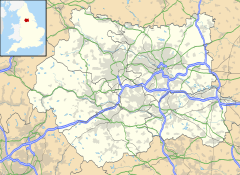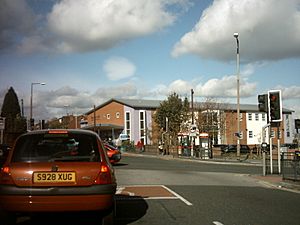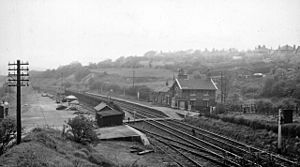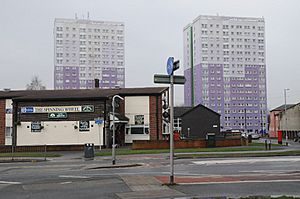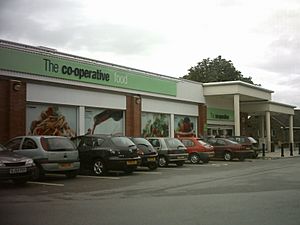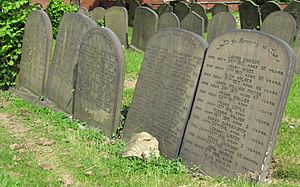Beeston, Leeds facts for kids
Quick facts for kids Beeston |
|
|---|---|
 View over Beeston |
|
| Population | 22,187 (2011 Census) |
| OS grid reference | SE294313 |
| Metropolitan borough | |
| Metropolitan county | |
| Region | |
| Country | England |
| Sovereign state | United Kingdom |
| Post town | LEEDS |
| Postcode district | LS11 |
| Dialling code | 0113 |
| Police | West Yorkshire |
| Fire | West Yorkshire |
| Ambulance | Yorkshire |
| EU Parliament | Yorkshire and the Humber |
| UK Parliament |
|
Beeston is a lively area in Leeds, West Yorkshire, England. It sits on a hill about 3 kilometers (2 miles) south of the city center.
Beeston's story goes way back to the medieval times. For a long time, it was a small village. Then, in the late Victorian era, it grew into a place where many people lived, especially those who worked in Leeds and nearby industrial areas like Holbeck and Hunslet.
In 2011, Beeston had about 22,187 people living there, including the area of Holbeck. Some parts of Beeston, especially around Cross Flatts Park, have faced challenges, while other areas are generally more well-off. Beeston is also home to the famous Leeds United football club stadium on Elland Road. It's also where the Hunslet rugby league club plays.
Contents
What's in a Name?
The name Beeston first appeared in the Domesday Book around 1086. It was written as Bestone. The name probably comes from old English words meaning 'estate' or 'village' known for 'bent-grass'.
The northern part of Beeston, which faces Leeds city center, became known as Beeston Hill in the 1800s. This area was once called Cat Beeston. The word 'Cat' might have come from an old English word for 'cat' or from a person's name, 'Cada'. If it's from 'Cada', then Cat Beeston would mean 'Cada's estate known for bent-grass'.
To the west of Beeston is Beeston Royds. The word 'royds' comes from an old English word meaning 'clearing' or 'open space'.
Another part of Beeston is called Cross Flatts. This name was first used in 1636. 'Flat' meant a 'level piece of ground' or 'field'. The 'cross' part might refer to how the fields were divided in a cross shape.
Beeston's Story
Beeston is first mentioned in the Domesday Book in 1086. At that time, it was given to a person named Ilbert de Lacy. In 1066, it was worth a good amount, but by 1086, it was considered empty. This was likely due to a difficult time called the Harrying of the North. The name Beeston suggests it was an Anglo-Saxon settlement. It was one of the ten smaller areas that made up the large Parish of Leeds until the parish was divided in the 1840s and 1850s.
During the medieval period, Beeston was known for sheep-farming. Monks from Kirkstall Abbey even grazed 240 sheep there! A small hospital was started around 1233, and a chapel dedicated to St Mary the Virgin might have also been built in the 1200s.
The oldest buildings in Beeston today are from the 1400s. Cad Beeston Manor House, a very old and important building, was built around 1420. Parts of Stank Hall Barn, which was used to store crops, were built between 1448 and 1490.
By the early 1600s, Beeston was known for making 'bone lace' (a type of lace). By the mid-1600s, people started coal-mining in the area.
Between 1740 and 1820, important toll roads (called turnpikes) were built through Beeston. These roads are now Elland Road and Dewsbury Road. By 1822, Beeston had 1,670 people. Before the 1800s, Beeston was a small mining village. But during the Industrial Revolution, land used for farming and old mining pits was quickly bought for new homes. By 1872, Beeston had 2,547 people, 537 houses, a railway station, and a post office. By the end of the 1800s, Beeston was mostly a working-class community living in 'back-to-backs' (a type of house where the back wall was shared with another house). Beeston was its own civil parish from 1866 to 1904, then joined Holbeck, and finally became part of Leeds in 1925.
On the night of 14 March 1941, during the Second World War, Leeds experienced its heaviest German air raid. Beeston had more bombs dropped on it than any other area of the city. Although Flaxton Terrace was damaged, most other bombs landed on Cross Flatts Park, causing less damage than in other parts of Leeds. The poet Tony Harrison, who was in Beeston that night, later wrote a poem about it. Holbeck Cemetery, in Beeston, is also a key part of his 1985 poem "v".
Beeston was once home to Waddingtons, a company that made card and board games. Their factory moved in the 1990s, and the building is now used by Nampak Cartons.
In 2006, parts of Beeston were used as the setting for the film Mischief Night.
Where is Beeston?
Beeston is an inner-city area very close to Leeds city center. It's separated from areas to the north by the M621 motorway. Middleton Park separates it from Middleton, and the Leeds Outer Ring Road separates it from Cottingley.
Beeston can be thought of as three main parts:
- Beeston - Parkside and Cross Flatts area: This part is to the west of Cross Flatts Park.
- Beeston Hill: This part is to the east of Cross Flatts Park.
- Beeston - Elland Road and Millshaw: This area is mostly for businesses and factories, located to the west.
These areas have likely been distinct since medieval times.
Beeston - Parkside and Cross Flatts Area
This area, sometimes called Beeston Village, has a shopping center with a Nisa food store and other smaller shops. The homes here are a mix of older Victorian houses and newer family homes. To the south of Dewsbury Road, there are many business buildings.
The health, economy, and safety in this area are generally similar to the rest of Leeds.
Beeston Hill Area
Beeston Hill has many older Victorian houses and newer social housing. In 2008, a big project was announced to build new homes and improve existing ones. Because this area has faced challenges, it received special European funding. Beeston Hill has a good number of people from different backgrounds, with about 40% of the population from Black and Minority Ethnic (BME) communities.
This area has faced some challenges, with health, economy, and safety indicators being lower than for Leeds as a whole.
Beeston - Elland Road and Millshaw Area
The western part of Beeston, around Elland Road, has many business parks. There are also many homes, mostly semi-detached and terraced houses, on the western edge of the Parkside and Cross Flatts area. This part also includes much of the older village side of Beeston, seen in many houses along Town Street and Millshaw.
Getting Around Beeston
Trains
A main railway line runs along the western edge of Beeston. Trains between Leeds and London King's Cross or London St Pancras use this line. However, there are no stations in Beeston itself, as the old Beeston station closed in 1953.
The closest train station is Cottingley, which is less than a mile from Beeston's Town Street. Trains from Cottingley go to Leeds and Huddersfield.
Buses
Beeston has many bus services along Dewsbury Road, Elland Road, and Town Street. These are mainly run by First Leeds and Arriva Yorkshire. Some popular routes include:
- A Park and Ride site for Leeds is located near Elland Road police station.
- First services 2, 12, 75, and 86 connect Beeston with Middleton, Belle Isle, and Hunslet.
- Service 65 connects Beeston with Morley and Gildersome.
- Services 51 and 52 link areas near Elland Road with Morley.
- Services 200 and 201 link the Dewsbury Road/White Rose side of Beeston to Morley.
- The frequent No. 1 bus service follows the path of the old Leeds Tramway route 5 through Beeston. It continues beyond Leeds to Lawnswood/West Park.
Roads
Beeston Hill and Beeston are connected to Leeds by the M621. This means they have good connections to the M621 motorway, as well as the M62, which runs close to Beeston to the south of Morley.
Businesses in Beeston
Many of Beeston's older factories and heavy industries have closed over the last forty years. However, there are still many business areas around Elland Road and south of Dewsbury Road. Beeston is also surrounded by areas popular with businesses, like Leeds city centre, Tingley, and many business districts along the south side of the River Aire. The nearby White Rose Shopping Centre provides thousands of jobs.
Learning in Beeston
Beeston is home to the Beeston Centre of Leeds City College and Elliott Hudson College. Beeston has one secondary school, Cockburn School, which specializes in arts.
Matthew Murray High School, located between Beeston and Holbeck, closed in 2004. It joined with Merlyn Rees High School in Belle Isle to form South Leeds High School. In September 2009, South Leeds High School became the South Leeds Academy.
In September 2017, South Leeds Academy was renamed Cockburn John Charles Academy. There are seven primary schools in the Beeston area.
Fun Things to Do and See
Beeston has many great facilities. It has two large health centers, Elland Road stadium, and the John Charles Centre for Sport. Leeds city center is very close, and the M1 and M62 motorways are easy to reach. Cross Flatts Park has lots of things to do, including 5-a-side football pitches, tennis courts, two play areas for different ages, and a bowling green.
Sports Stadiums
Beeston is home to two stadiums:
- Elland Road: This is the home of Leeds United AFC. It's a large stadium with seats for 39,640 people, located next to the M621 in northern Beeston.
- The South Leeds Stadium: This is part of the John Charles Centre for Sport and is located on Middleton Grove. It's home to Hunslet rugby league club. It also hosts athletics and swimming in the new Aquatic Centre, which opened in 2008 and has an Olympic-standard swimming and diving pool. The center also has indoor bowling, an indoor Tennis Centre, an athletics stadium, 5-a-side football pitches, rugby pitches, and outdoor gym equipment.
Cross Flatts Park
Cross Flatts Park is a large park, covering about 17.8 hectares (44 acres), right in the middle of Beeston. In the past, the park faced some challenges, but thanks to the Council and community groups like Friends of Cross Flatts Park, it has been made much cleaner, safer, and more welcoming.
The park has a big area for different sports, including five-a-side football pitches, basketball courts, and tennis courts. There's also an artificial cricket pitch, a children's play area, and outdoor gym equipment. The park is where the annual Beeston Festival takes place every June. In summer and school holidays, it hosts many activities for young people. The park also hosts a weekly 5 km Parkrun every Saturday morning at 9 am. Over 1,000 runners have taken part since it started in 2013.
Holbeck Cemetery
Holbeck Cemetery in Beeston opened in 1857 and stopped new burials in the 1940s. Thousands of people were buried there. Many were in 'guinea graves', where several unrelated people shared the same plot. These graves were named after the shared headstones, where a single line of writing cost one guinea (21 shillings).
Henry Rowland Marsden, a famous industrialist and former mayor of Leeds, is buried in Holbeck Cemetery. His family grave has a special memorial.
The poem "V" by Tony Harrison, written in 1985, talks about visiting Holbeck Cemetery.
Greenhouse
In 2008, Shaftesbury House, an old hostel built in 1936, was turned into the Greenhouse. This is an eco-friendly housing project. The building had been empty for years and was almost torn down.
The Greenhouse has 172 homes, offices, and other spaces. It's one of the UK's first low-carbon housing developments. It uses wind turbines, solar panels, and ground source heating. It also uses energy-efficient materials and recycles rainwater. The project has won many awards for its focus on sustainability and for helping to improve the area.
Places of Worship
Beeston has at least ten churches from different Christian groups, including Church of England, Roman Catholic, Methodist, and Baptist. The Anglican churches of St Mary on Town Street and St Luke on Malvern Road were built in the 1870s, though St Mary's is on the site of a much older church. The more modern church of St David Waincliffe on Dewsbury Road, built in the 1960s, won an award for its design.
There are also three mosques in Beeston, all in the Beeston Hill area. Beeston also has a Sikh Gurdwara.
Local Government
Most of Beeston is part of the Beeston and Holbeck ward of Leeds City Council. This ward has usually been represented by Labour councillors since it was created in 2004.
Parts of Beeston Hill are in the Hunslet and Riverside ward. This ward was created in 2018 and has also usually elected Labour councillors.
Hilary Benn (Labour) has been the MP for the area since 1999. Before that, Beeston was part of the Morley and Leeds South constituency.
Famous People from Beeston
Many interesting people have connections to Beeston:
- The writer Willis Hall went to Cockburn High School in Beeston.
- Richard Hoggart, an academic and author, also attended Cockburn High School.
- The poet Tony Harrison grew up on Tempest Road and went to Cross Flatts county primary school.
- More recently, actress Holly Kenny, who was in the TV show Waterloo Road, was a student at Cockburn School.
- The musician and bandleader Ivy Benson grew up in Beeston. Her former house on Cemetery Road has a special blue plaque.
- Former England and Leeds United footballer Paul Madeley was born in Beeston.
- Former international rugby star Jason Robinson went to Cross Flatts Park Middle School and Matthew Murray High School. He started his rugby career with Hunslet Hawks.
- Leigh Francis, famous for his character Keith Lemon, was born in Beeston.
Community Response to the 2005 London Events
Beeston gained national attention after the events in London on 7 July 2005, when it was learned that some individuals involved had lived in the area. Police investigated properties in Beeston.
After-effects
When the connection between the London events and Beeston became known, community and religious groups in Beeston quickly came together to speak out against the actions. There was a strong sense of unity among people in the community. Two "Beeston Together for Peace" marches were held, with hundreds of people joining. The second march ended at Millennium Square in Leeds city center, where people from other parts of Leeds joined for a special gathering focused on different faiths working together.
Beeston in the News
After the London events, Beeston was featured in local, national, and international news. Journalists from places like North America and Japan came to the area to report on how the community was reacting. The news reports varied; some were understanding, even describing Beeston as a 'leafy suburb', while others presented a less positive picture.
The Guardian A year later, a journalist from The Guardian visited Beeston to see beyond simple stereotypes. The article reported that the community in Beeston had largely condemned the actions.
NBC NBC described Beeston as a "poor racially mixed community" with small row houses built for factory workers. The article noted that the neighborhood has long welcomed immigrant communities, from Asia in the 1960s to Eastern Europe and Africa today.
Los Angeles Times The Los Angeles Times called Beeston an "ethnically mixed, downtrodden suburb." It described people from different backgrounds sharing what they knew.
International Herald Tribune One year after the London events, the International Herald Tribune described Beeston as a "grim northern neighbourhood." The paper also noted that it is a "poor and racially mixed neighbourhood of back-to-back row houses" where different waves of immigrants have added to the Victorian-era cityscape.
Socialist Worker The Socialist Worker focused on Beeston's positive side. It reported on the 'Beeston United for Peace' gathering, which was organized by local groups. A march of 150 people from Hyde Park was also covered.
Where is Beeston on the Map?
 |
Wortley | Holbeck | Hunslet |  |
| New Farnley, Gildersome | Belle Isle | |||
| Churwell, Morley | Tingley | Middleton |
- Images of England — details from listed building database (465423) Manor House, Cad Beeston; grade II* listed
- Images of England — details from listed building database (465422) Cad Beeston; grade II listed
- The ancient parish of Leeds: historical and genealogical information at GENUKI (Beeston was in this parish).
See also
 In Spanish: Beeston (Leeds) para niños
In Spanish: Beeston (Leeds) para niños


